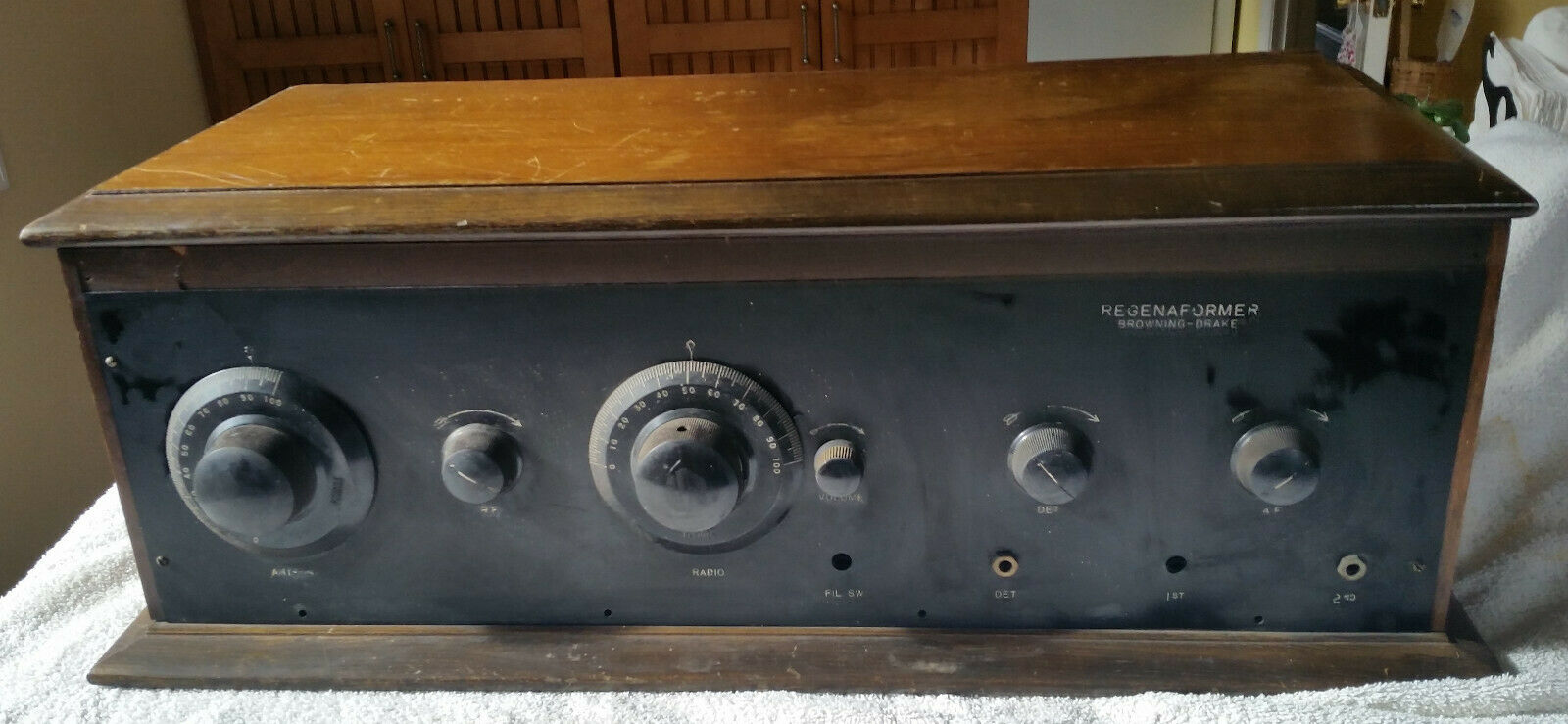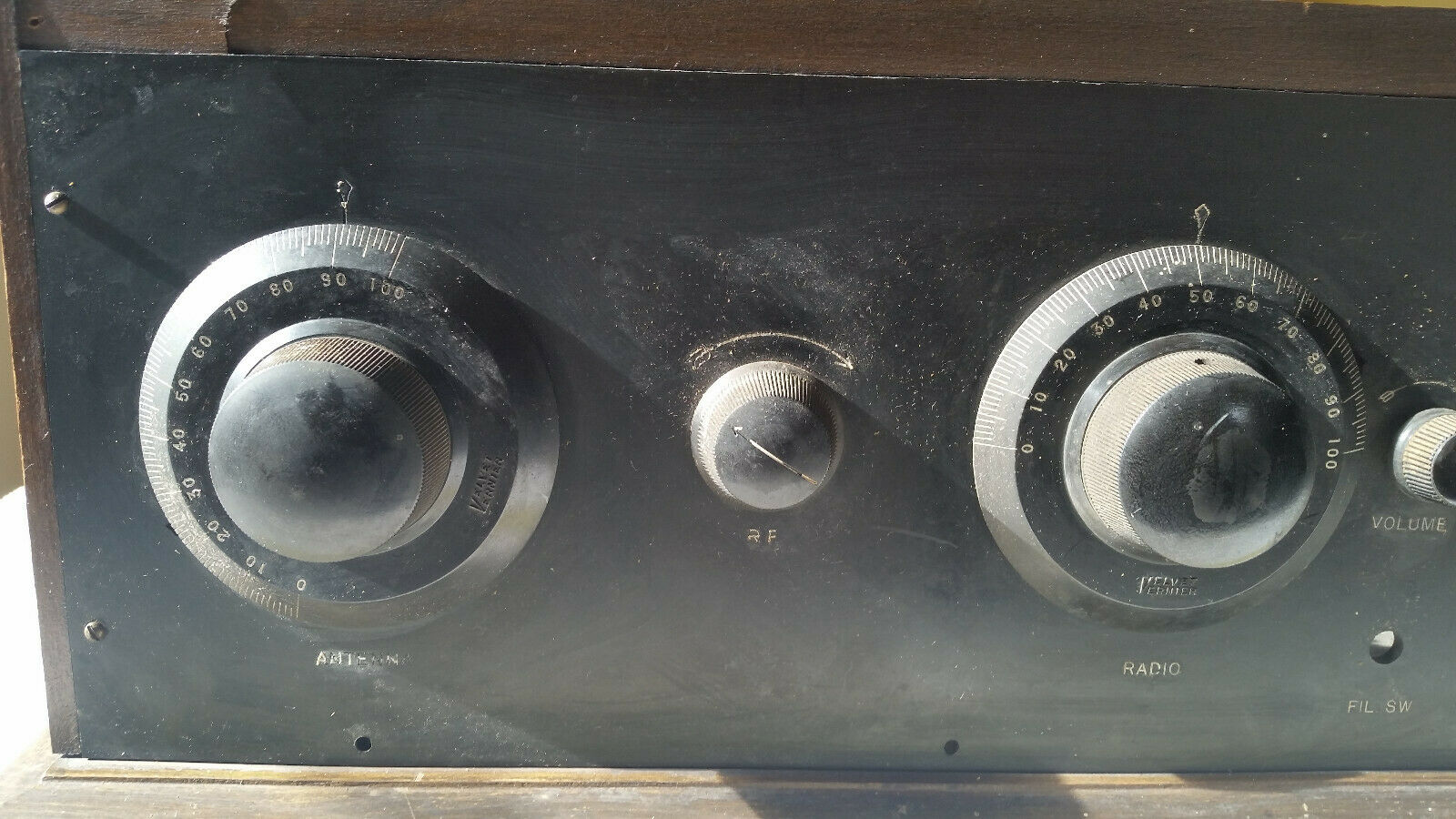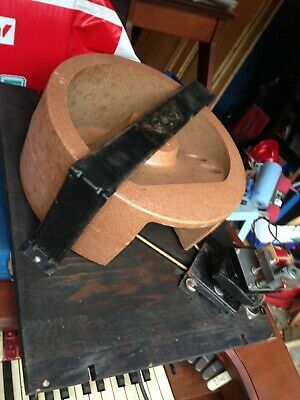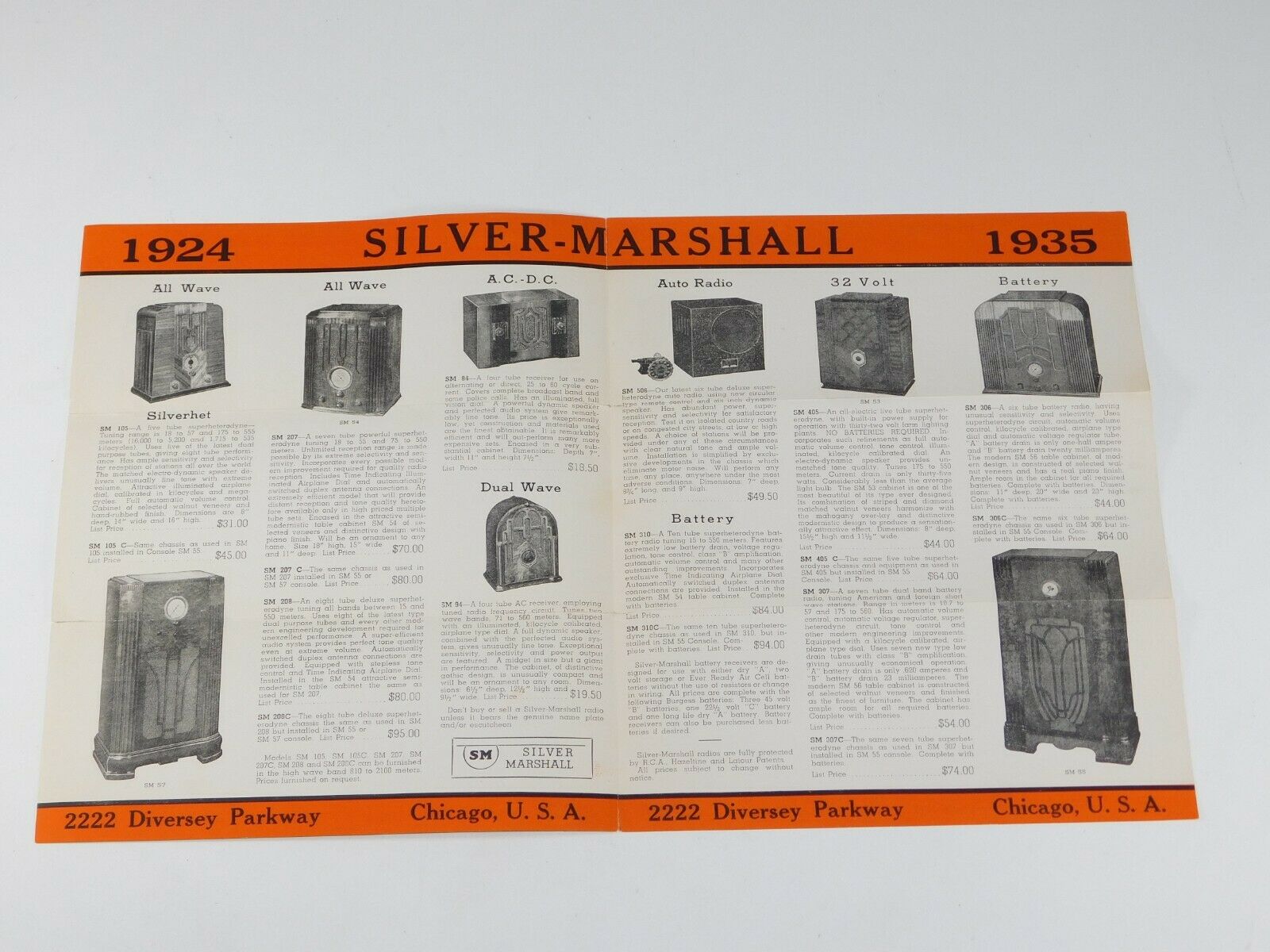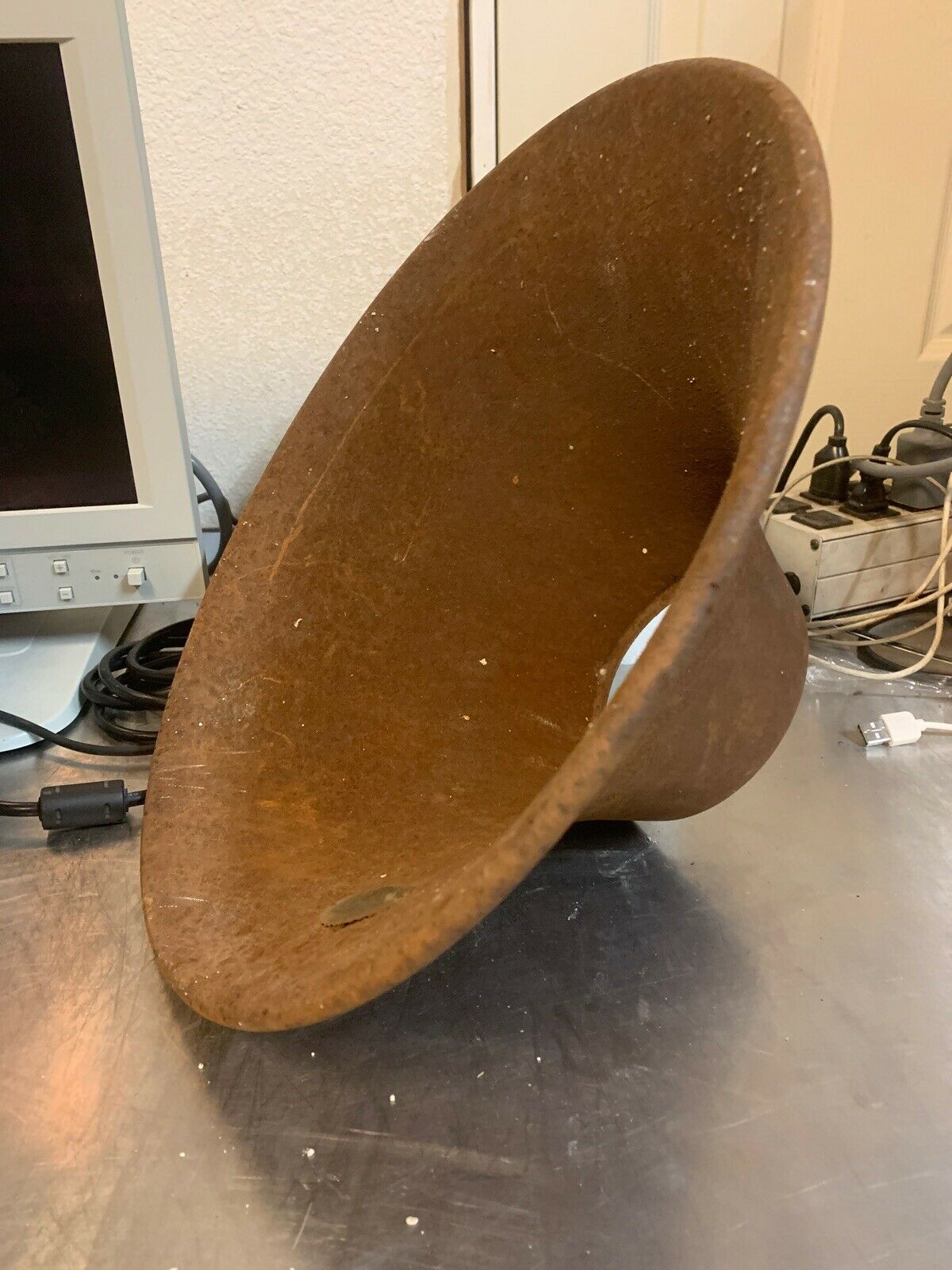-40%
Vintage 1927 Radio Browning-Drake Regenformer 5R Receiver 4 Vacuum Tubes
$ 712.27
- Description
- Size Guide
Description
Vintage Browning-Drake Regenformer 5R Receiver radio 4 Vacuum Tubes 1927These radios were kits, and this 94 year old radio was purchased, assembled, and used in Providence, RI. My great uncle worked on it on and off and his father used it when it was new.
There are very few of these left in the world. I'm including a number of pages of history and wiring diagrams with the radio.
Includes
4 Vacuum tubes
all of which look to be in good shape.
1 x Radiotron UX-201A
2 x Radiotron UX-112-A
1 x Brightston True Blue Z
The wooden case has some scratches.The internals are free-floating, but look to be in very good shape.
Width: 26 1/2" x Height 12"
Weight 29.4 lbs.
Amrad, Crosley
And a little history of the company that made this antique radio:
Browning-Drake Radios
By Wally Worth
The founders of Browning-Drake Corporation, Glenn Browning and Frederick Drake, were at Harvard University in 1923 and engaged in research to increase the efficiency of radio frequency transformers. At the time, RF transformers were only 20 to 30 percent efficient, and thus were losing a lot of the energy normally passd on to the detector tube.
These two men, after much experimentation, found that the losses were caused by too much capacity between the primary and secondary coils of the radio frequency transformers. They had formulated an idea to manufacture these transformers with much lower capacity by making the primary winding very narrow, and placing it in a slot at one end of the coil, instead of along the surface of the secondary winding.
THE NATIONAL COMPANY
Browning-Drake approached the National Company, then on Brookline St. in Boston, with the proposal of manufacturing this new type of transformer, and mounting it on the rear of National's variable condenser to form the "Regenaformer." The Regenaformer included an adjustable tickler coil to control regeneration. National also manufactured the antenna coil and mounted that on another National variable condenser. With this arrangement, the National tuners were born.
These tuners were sold as part of a kit, along with other components, to be mounted on a breadboard to form the Browning-Drake receiver that included two tubes. These kits sold so well that other kits with 2- or 3-tube audio amplifiers were placed on sale.
There were many adaptions of chassis layouts and tube styles pictured in the various magazines of the day, and they enjoyed a brisk sale because of the sensitivity of the Regenaformer. These kits, and later complete radios, gave the Neutrodynes of that era a good run for their money, since they were much easier to operate, and more sensitive.
As an aside, I remember working for Boston Gear Works as a sales engineer and calling on the National Company plant, then on Jackson St. in Malden, Massachusetts, and talking with their engineers and draftsmen. Several old timers there remembered Glenn Browning coming into the plant and discussing the manufacturing processes of their coils and Regenaformers. Browning even had a small office there where he oversaw the making of parts.
THE BROWNING-DRAKE CORPORATION
Both Browning and Drake were closely involved with the National Company for many years, but Glenn Browning terminated his relationship with National in July 1927 to devote his energies to the newly formed Browning-Drake Corporation, which had moved across the river to Cambridge to a larger plant.
Later the various models put out by the Browning-Drake Corporation were sold using a 4- or 5-tube circuit with two tuning dials, one at each end of the front panel, or with both dials at the left hand of the panel. These tuning dials were mostly the National Company's "Velvet Vernier" dial with variable-ratio tuning used in the radio.
Later, 6-, 7-, and even 8-tube models were produced, but these had single-control tuning in the center.
Of the many kits and finished radios that were put on the market, only the panels of the finished receivers were engraved with the Browning-Drake name. The kit sets were engraved only with the control function. Thus, it is easy to distinguish between kit sets, of which there were many, and the complete radios built by the Browning-Drake Corporation.
Most of the complete models were housed in fancy 2-tone cabinets and finished in mahogany or walnut. Cabinets used were made by the Fritts, Signal and Corbett companies. The panels almost always were mahogany-colored Bakelite with a high-gloss finish to make a very pretty set.
When looking at these sets and trying to resurrect the model number, remember that the "R" in the model number means that the audio amplifier tubes are resistance-coupled. The model numbers without the "R" are transformer-coupled.
Webmaster Notes: This article was first published in Antique Radio Classified. We appreciate Mr. Worth allowing us to include his invaluable information here on the Browning Laboratories, Inc. website! We have only edited those parts of his article that made reference to pictures that were a part of the ARC write-up.
At age 15, Wally Worth began saving his paper route money to buy parts for 1-tube sets. Fifty years later, in 1986, he started to collect anything that needed cabinet work. His diverse collecting tastes include crystal sets, 1920's battery AC sets, transistor and multiband sets, novelty radios, tubes, and both horn and cone speakers.
----
Below is interesting article on this radio:
Radio News for February, I926
The Browning-Drake Regenaformer by Volney D. Hurd
The Browning-Drake receiver has acquired considerable popularity throughout the country, so that an article dealing with recent improvements in this circuit will be welcomed by our readers. Full descriptions of the circuit are given, which will enable the reader to duplicate Air. Hurd's receiver, while the non-technical explanation of its theory tells clearly how the receiver works.
After all is said and done, the prime requisite in radio is a set that will prove to have good quality on the audio end and have sufficient radio frequency amplification to get down to the "static level." We will not discuss audio amplification, since that has been handled at length in this magazine. Any type of good audio amplification may be applied to the set under consideration.
This brings us to the sensitivity of a receiver. The static level has been described many times as a wall beyond which no reception is possible. In other words, a set may be so sensitive that the station between the receiver and the desired broadcast station is louder than the program being sent out. It is quite desirable that a set should be sensitive enough to get down to this level. Beyond this point the only result will be noise. This has been borne out by thousands of experiments with super-sensitive receivers.
The set we are about to describe is sensitive enough to get down to this level and does so with a minimum amount of tubes and apparatus in keeping with good tone quality. It has been found that the greatest losses in radio frequency amplification have ordinarily been transformer losses. We don't mean by this the so-called "low-loss" coil, as it has been explained in the radio press of recent months. We are dealing with the transfer of energy from the primary to the secondary of a radio frequency transformer. Although we get an amplification of, say, seven or eight in an ordinary tube, the actual amplification which gets over into the grid circuit of the next tube with a tuned transformer drops to about three or less.
Developing the Circuit
We know a regenerative detector gives extremely high radio frequency amplification and is an extremely economical method of utilising the ever necessary detector tube. The writers have felt that a radio frequency tube placed ahead of a regenerative detector using a truly efficient transformer that actually gives a step-up will prove to be all that is necessary in order to get down to the static level. It is just this very transformer that has finally been developed by two Harvard University Engineering School Research Fellows, Frederick H. Drake and G.H. Browning.
The method they used in attacking the problem of obtaining the correct design of the tuned radio frequency transformer was unusual, as well as interesting. The circuit shown in Fig. 1, which comprises a tube as a radio frequency amplifier and a tuned transformer, was attacked from a theoretical standpoint, and the circuit completely solved mathematically. The theory predicted the correct constants for maximum amplification, but it was only after a slot wound primary had been adopted that 90 per cent. of the predicted amplification was obtained.
The capacity coupling between the primary and secondary was the cause of most transformer losses. In order to get a large amount of energy into the secondary, a great number of turns should be wound on the primary. If these should be wound according to the regular practice, such as directly underneath or on top of the secondary, the capacity coupling would undo all the good that had been achieved by using these extra turns. Capacity coupling may be described as the condenser effect between the primary and the secondary of the radio frequency transformer; that is, the primary acts as one plate of a condenser, and the secondary as the other. The problem to be solved was, therefore, a question of using the necessary number of turns on the primary, still keeping the capacity coupling very small and, at the same time, having the co-efficient of coupling relatively high.
This was finally achieved after much experimental work by winding the primary in a narrow groove with fine wire. Thus the primary became a closely bunched inductance, giving but little capacity coupling, and at the same time effecting a relatively high degree of coupling. With this transformer, a sensitive set was developed, a set sensitive enough to get down to our old friend, "static level."
The controls are cut down to a comfortable minimum, since only two tuning controls are used. The transformer tunes very sharply, and gives an amplification with a tube, such as was mentioned before, of about ten or twelve compared with the three or four of an ordinary transformer. The sharpness of the tuning is further augmented by the introduction of regeneration, which not only increases the sensitivity of this particular circuit, but also aids in sharpening up the tuning. The first tube not only acts as an amplifier, but also as a blocking tube, preventing the neighbours from being disturbed by radiation.
The antenna system utilises a tapped coil and a small condenser in series with the antenna itself. This also makes the first circuit tune quite sharply. With the addition of a good audio amplifier, we have, therefore, a set that is as sensitive as possible within the limits of practicality, which is selective and which is simple to tune. In addition, the combination of constants used seems to produce an unusually good quality of tone which, which put through a good audio amplifier, gives an accurate reproduction of the original program.
We can hardly take space at this point to discuss results with this set, except ill a very brief way. Thousands of these have been made by experimenters throughout the country, and the only set with which it is compared is the super-heterodyne. It may be used very successfully on an extremely short antenna, say thirty or forty feet. As to distance reception, it is sufficient to say that verified reception has been obtained by Mr. L. D. Yont, located in Boston. from KGO, Oakland, Calif.; KHJ, Los Angeles, Calif.: Mexico City; Calgary, Canada and Madrid, Spain.
Constructional Data
The layout of the ports entering into the complete receiver has been so planned as to make the connecting leads as Short as possible. Thus, the R.F. amplifier tube is placed between the antenna tuning system and the regenaformer, while the three other tubes are placed at the right of the second tuning condenser. The two variable air condensers which support the coils should be mounted so that the rotor plates move toward each other. Be sure the stator plates of the condensers are connected to the grid of the tubes, as this will reduce body capacity when tuning. Be sure to solder connections directly to the wire of the antenna coil and the secondary of the regenaformer.
Sometimes the 1 mf. condenser, acting as a by-pass across the "B" battery, can just as well be omitted if the leads to the "B" battery are short. This is the reason it is marked optional. It will be noticed that the rheostats are connected in an unusual way, which facilitates the use of the voltmeter, so that it reads the maximum volt-age across the filament of all tubes. This voltage is controlled by rheostat No. 2. Rheostat No. 1, which has 30 ohms resistance, really acts as a volume control regulating the filament voltage of the first tube.
The coil data is as follows
The input, or antenna coil, consists of 50 turns of .No. 20 D.S.C. wire wound. on a piece of. 3-inch hard rubber or bakelite tubing. This coil is usually tapped in the center so that its use with either a long or short antenna may be flexibly arranged. Of course, this means the center tap would be used with a long antenna, while the short antenna would be brought in at the high potential side of the coil.
The regenaformer is constructed as follows
Seventy-seven turns of No.20 D.S.C. wire should be wound on another piece of 3-inch tubing, which should be about 5 inches long in order to allow for the mounting of the tickler. This winding is the secondary of the Browning-Drake tuned radio frequency transformer and is tapped at the 14th turn for the purpose of neutralization.
The tickler consists of 30 turns of wire, which may be about No. 28 or 30 D.S.C. wound on a piece of 2-inch tubing which is mounted on a rod. This rod may be fastened by end pieces to the variable condenser so as to bring it in proper relation to the coil in order to cause regeneration. Roughly, this tickler coil is about under the last turn of wire.
We now come to the primary, which is the really important and principal part of this receiver. As discussed in this article, through scientific development, it was found advisable to wind this in a slot with very fine wire in order to reduce the capacity coupling between the primary and the secondary. A small wooden disc about 3/8 or 1/2 inch thick should be obtained with a diameter which will just permit it to slide snugly inside of the 3-inch tubing upon which the secondary is wound. On the outer rim, or tread. of this wooden disc a slot should be cut 1/8 inch wide and 1/8 inch deep. Now 24 turns of No.30 D.C.C. wire should be wound in this slot in the so-called "jumble" fashion, the arrangement of the turns not being at all critical. When the ends have been brought out and securely fastened in place, the primary is a complete unit. This should be slipped inside the secondary in place so that the slot comes under the first turn. It will be seen at this point that the fit of this wooden disc must be quite snug in order to keep it in place inside the secondary tubing.
The antenna condenser is a .0005 mf. variable, while the regenaformer may be tuned by either a .00035 or a .00025 mf. variable condenser, The fixed condenser in series with the antenna is a .0001mf. The by-pass condenser of the first audio transformer may be .001mf or .002mf.
Many people believe that separate rheostats for the detector tube help bring in distant stations. In the case of DV2, DV3, UV-201A, UV-199, WD-12 and WD-1l, it seems to make no difference in volume whether the detector has a separate control or not. In fact, it is better to run the detector tube at rated voltage on the filament, as cutting down this voltage tends to distort signals. This is why the detector and two audio tubes are connected to the same rheostat.
It is best to use DV3's or UV-199 tubes in the set, though 201's may be used if the constructor will take pains to balance the receiver properly. However, if small voltage tubes are used, the "A" and "B" batteries may be put into compartments built in the cabinet, making the receiver portable for vacation use.
In making connections, the grid leads to tube 1 and tube 2 should be kept as short as possible. The leads running to the balancing condenser should not be placed parallel to those going from the primary of the regenaformer to the plate of the first socket. The connection from the .00011 mf. condenser in the antenna circuit should go direct to the grid of the first tube. if a short antenna, say 40 feet long. is used, the connection to the middle of the coil being used for an antenna whose total length is 100 feet or more.
A few notes on tuning may be helpful, though actually operating the set is the only way one can acquire the knack of doing DX work. If the set is performing normally. the rotor coil LP can be tuned to such a position that placing a finger on the Stator plates of the .00035 mf. condenser gives a "pluck" in the receivers, the circuit containing L2 is oscillating. VVith the rotor coil in that position, turn the dial of the .00035 condenser until a whistle is heard. Turn dial of the .0005 mf. condenser until this whistle is loudest. Adjust the rotor coil until the whistle disappears then a slight turning back of this dial should bring in the desired station signal.
The complete wiring diagram of the Browning-Drake receiver. Notice especially the connections of the filaments and rheostats, permitting proper use of the volt meter.
This outline shows the general layout of apparatus in the Browning Drake receiver. Notice that there is not much crowding. and a neatly arranged Set results.
Much of the wiring in the receiver is done underneath the sub panel This gives the set, as viewed from above, a neat and clean appearance. without the usual jumble of bus-bar wiring. The illustration shows the sub-panel from beneath, with the method of making connections.
This article was printed in the Radio News for February 1926, A USA radio magazine.
Amrad, Crosley
